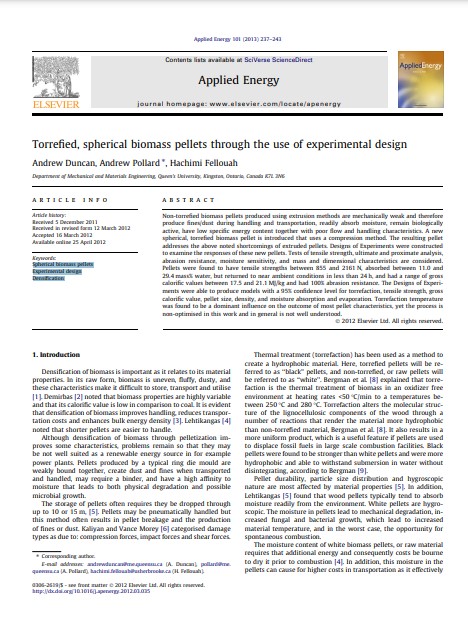Torrefied, spherical biomass pellets through the use of experimental design.
Bosque Modelo:
Eastern Ontario
Temática:
Cambio climático
Tipo de documento:
Artículo científico
Resumen
Non-torrefied biomass pellets produced using extrusion methods are mechanically weak and therefore produce fines/dust during handling and transportation, readily absorb moisture, remain biologically active, have low specific energy content together with poor flow and handling characteristics. A new spherical, torrefied biomass pellet is introduced that uses a compression method. The resulting pellet addresses the above noted shortcomings of extruded pellets. Designs of Experiments were constructed to examine the responses of these new pellets. Tests of tensile strength, ultimate and proximate analysis, abrasion resistance, moisture sensitivity, and mass and dimensional characteristics are considered. Pellets were found to have tensile strengths between 855 and 2161 N, absorbed between 11.0 and 29.4 mass% water, but returned to near ambient conditions in less than 24 h, and had a range of gross calorific values between 17.5 and 21.1 MJ/kg and had 100% abrasion resistance. The Designs of Experiments were able to produce models with a 95% confidence level for torrefaction, tensile strength, gross calorific value, pellet size, density, and moisture absorption and evaporation. Torrefaction temperature was found to be a dominant influence on the outcome of most pellet characteristics, yet the process is non-optimised in this work and in general is not well understood.
Información Bibliográfica
Autor:
Duncan, A., Pollard, A., & Fellouah, H
Revista:
Applied energy
Año:
2013
N°:
-
País :
Canadá
Páginas:
237 - 243
Volumen:
101
Idioma:
Ingles
Palabras claves
Spherical biomass pellets Experimental design Densification





